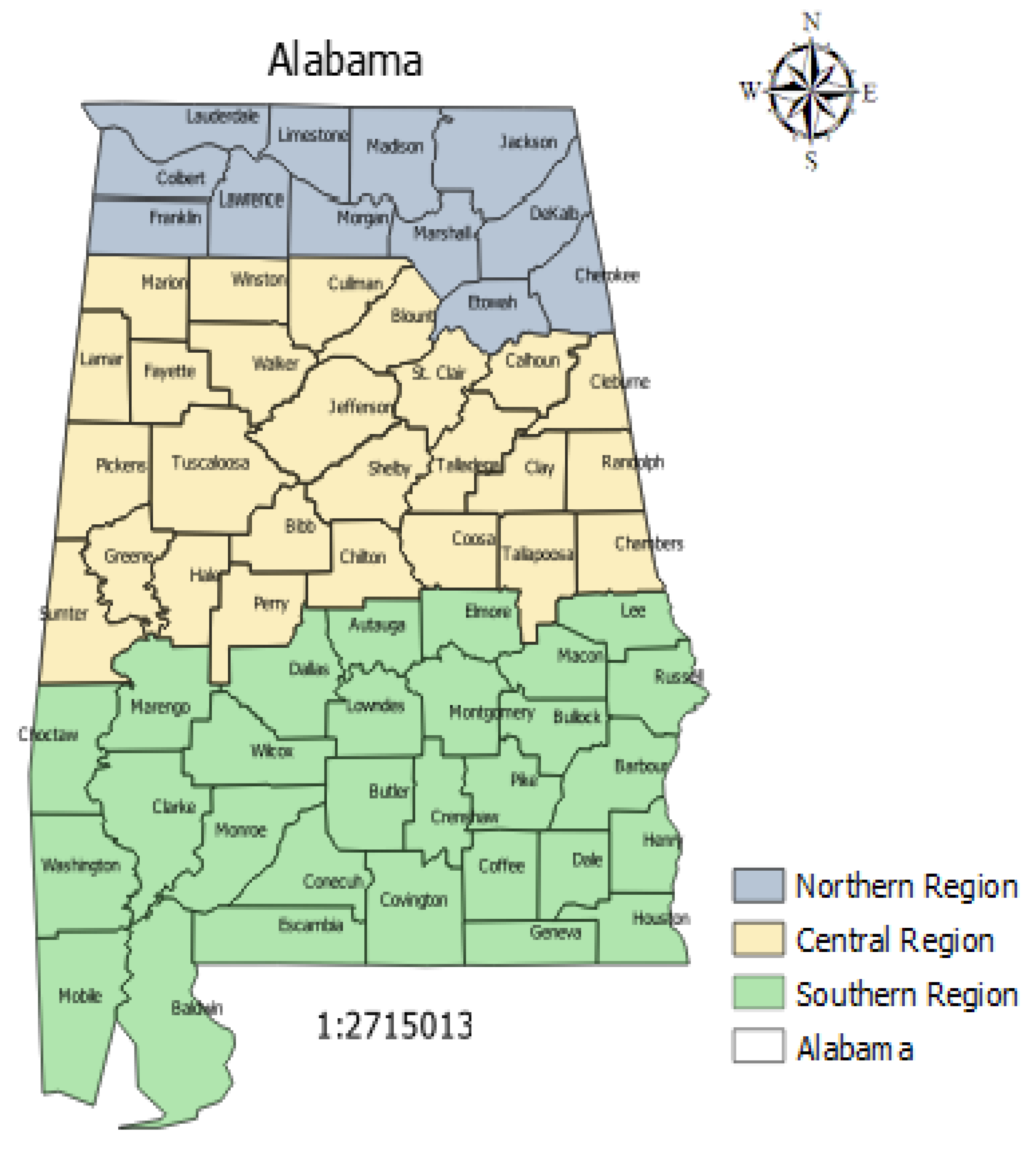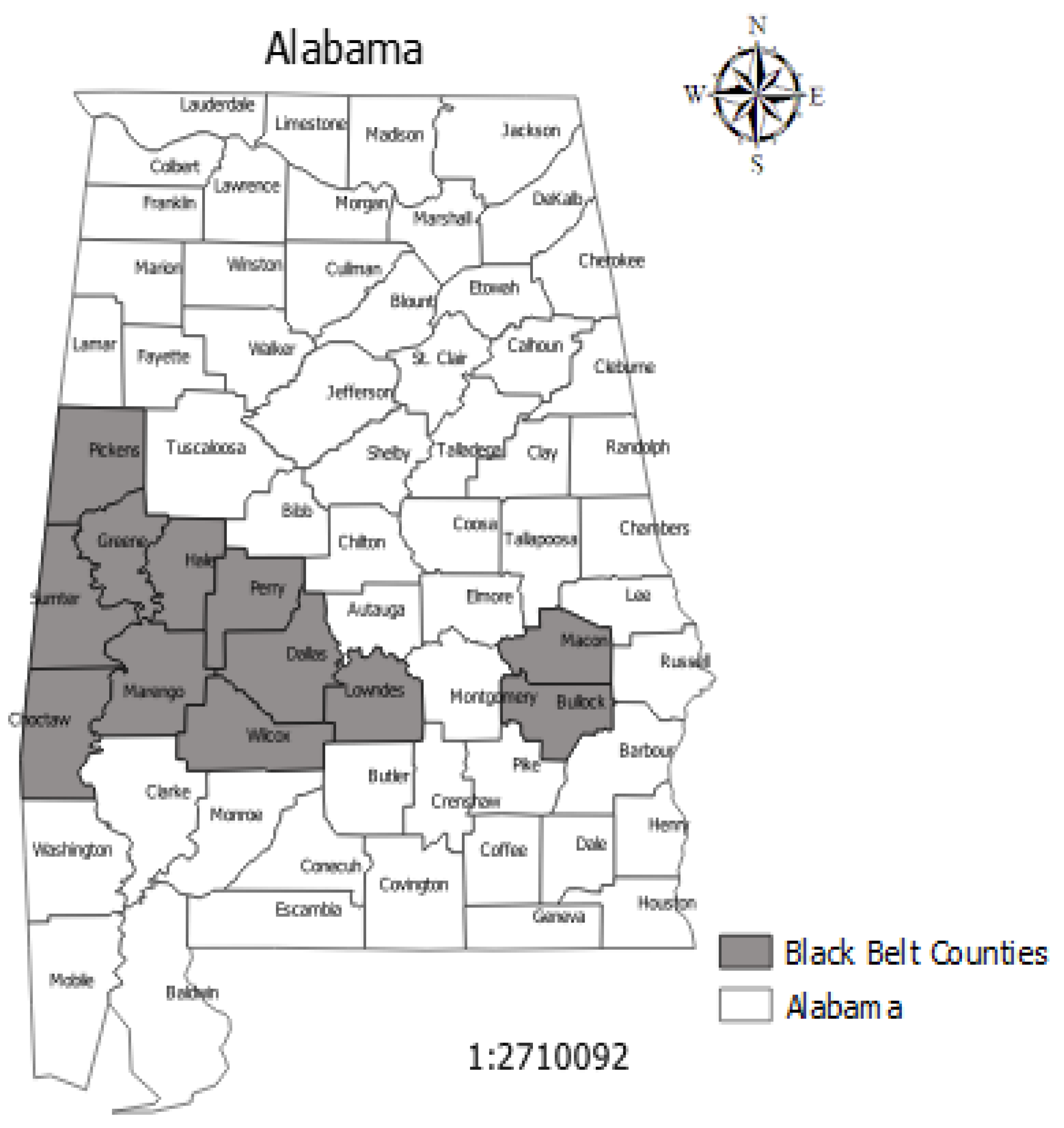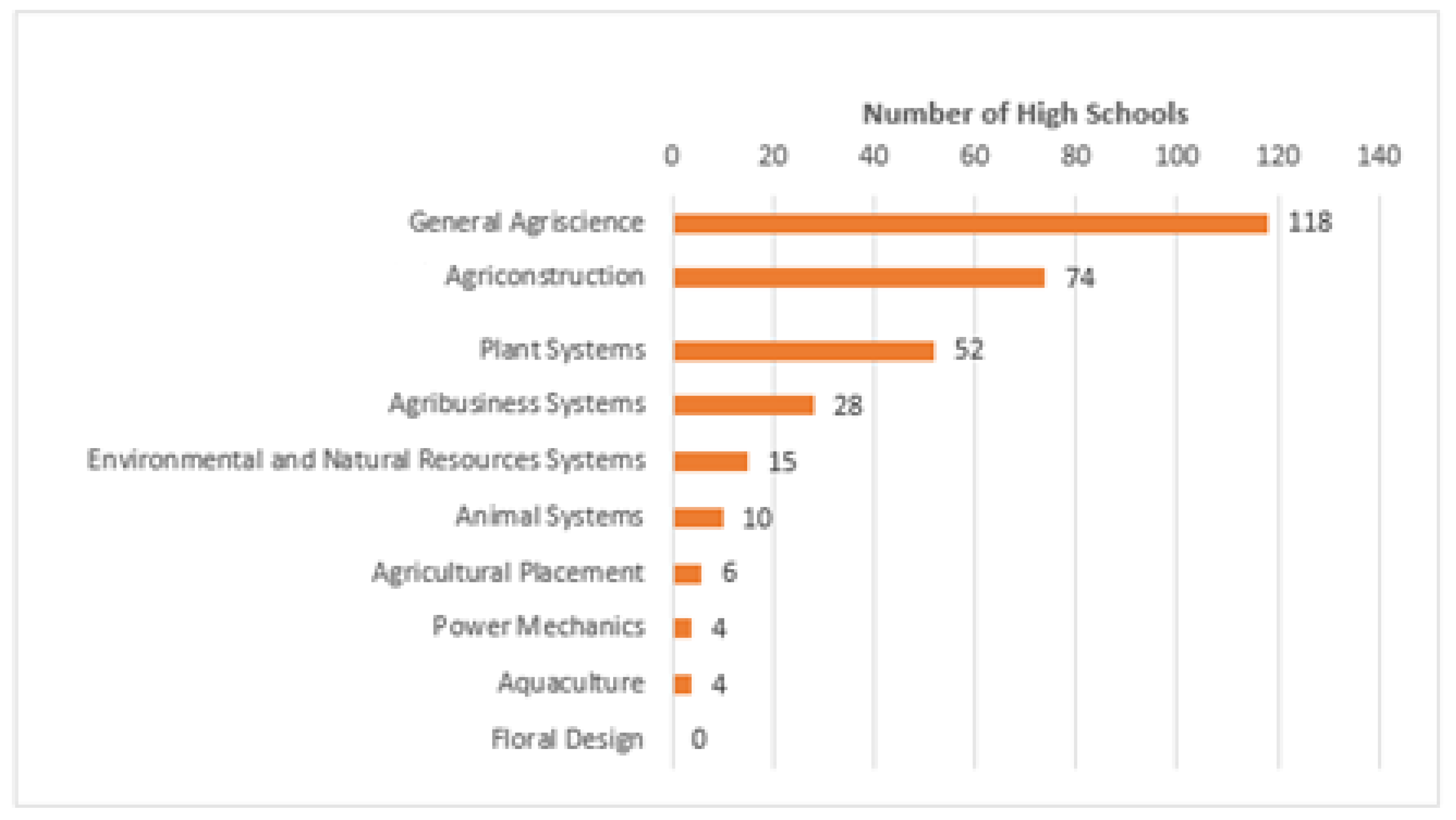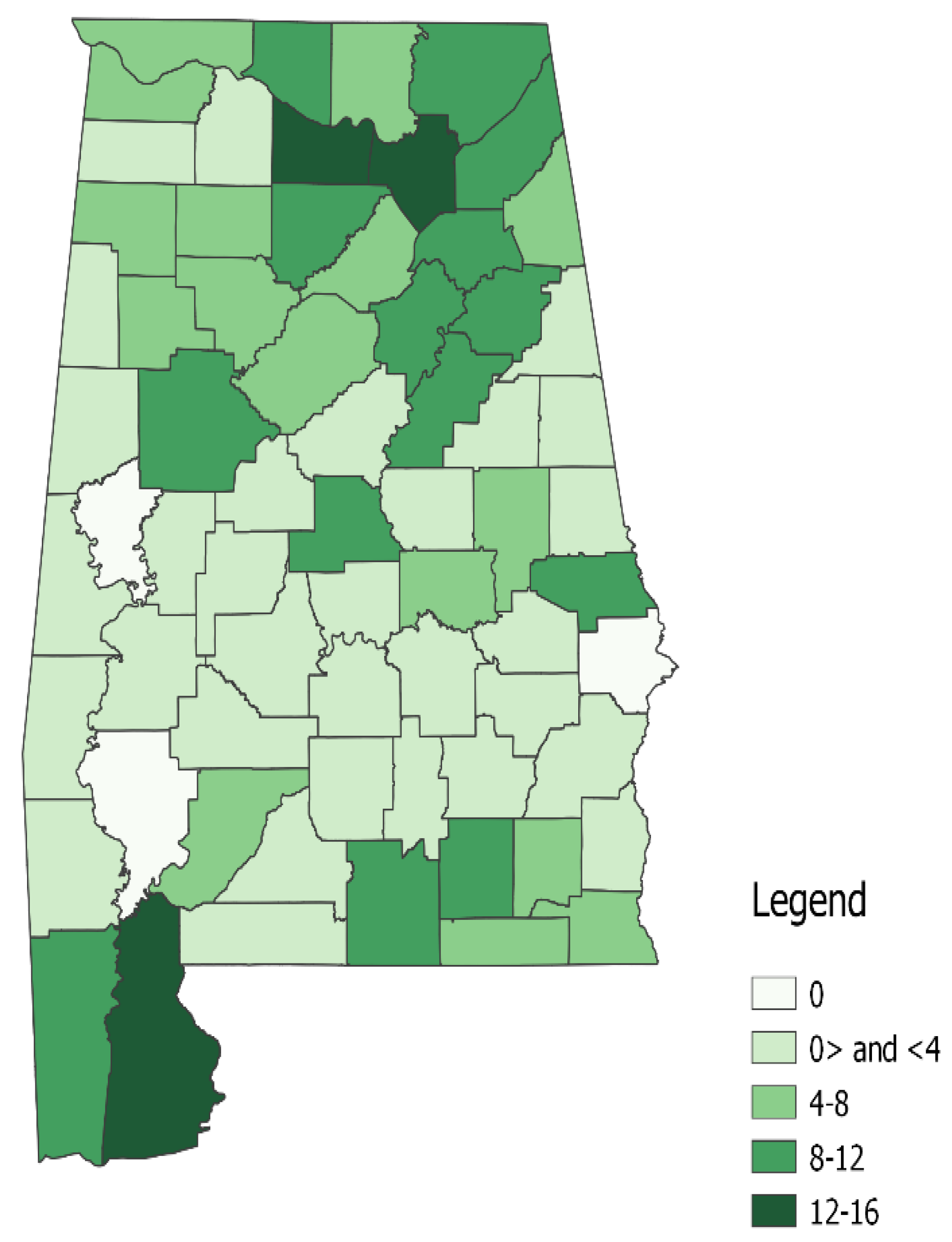Agricultural Education in Today’s School System: An Evaluation of Agricultural and Related Science Courses among High Schools in Alabama, USA
Abstract
:1. Introduction
Research Questions
- Does the average number of high schools which offer courses in agriculture-related fields differ across Alabama’s regions (Central, North, and South as well the Black Belt)?
- Does the average number of high schools with courses in agriculture-related fields in Alabama’s Black Belt differ from the rest of the state?
- Does the average number of agriculture-related courses in high schools vary across Alabama’s regions?
2. Literature Review
- Established internship programs in collaboration with the private sector for high school students so that students’ interest in agriculture can be enhanced.
- Opened multipurpose centers with the aim of enhancing youth involvement in agribusiness and forestry.
- Started workforce development programs that can increase career awareness of agriculture, forestry and agribusiness among public school students.
- Enhanced the number of agriculture-science programs by 15%.
- Organized career awareness programs to ignite passion among youth for agriculture, agribusiness, and forestry.
Conceptual Framework
3. Methodology
Data Collection and Analysis
4. Results and Discussion
4.1. Spatial Differences in Agriculture-Related Courses Offered in Alabama’s Black Belt Counties and the Other Alabama’s Counties
4.2. Spatial Aspects of the Prevalence of Agriculture-Related Courses in Alabama’s High Schools
4.3. Spatial Differences in Agriculture-Related Courses across Alabama’s Northern, Central, and Southern Regions
5. Conclusions
Author Contributions
Funding
Conflicts of Interest
References
- Agclassroom.org. 2017. Excellence in Teaching Award 2017. Available online: https://www.agclassroom.org/teacher_award/17.cfm (accessed on 3 November 2017).
- Aitbayevaa, Gul’zamira D., Mariyash K. Zhubanovaa, Tulebike A. Kulgildinovaa, Gulsum M. Tusupbekovaa, and Gulnar I. Uaisova. 2016. Formation of Education Clusters as a Way to Improve Education. International Journal of Environmental & Science Education 9: 3053–64. [Google Scholar] [CrossRef]
- Alabama Department of Agriculture & Industries. 2015. Strategic Plan to Grow Alabama’s. Montgomery: Alabama Department of Agriculture & Industries. [Google Scholar]
- Alabama Department of Education. 2008. Alabama Course of Study Career and Technical Education. Available online: http://www.alabamaffa.org/Teacher_Page_Documents/AFNR%20Course%20of%20Study.pdf (accessed on 3 November 2017).
- Alabama State Department of Education. 2017. Alabama State of Education Directory. Available online: http://web.alsde.edu/home/schoolinfo (accessed on 15 October 2017).
- Frenkel, Amnon, and Eran Leck. 2017. Spatial aspects of education–job matching in Israel. Regional Studies 51: 1063–76. [Google Scholar] [CrossRef]
- Ilnicki, D. 2009. Main Spatial Aspects of the Functioning of Higher Education Institutions in Poland. European Spatial Research and Policy 16: 79–92. [Google Scholar] [CrossRef]
- Ingram, Deborah D., and Sheila J. Franco. 2012. NCHS urban-rural classification scheme for counties. Vital and Health Statistics 2: 1–65. [Google Scholar]
- Kim, Hae-Young. 2013. Statistical notes for clinical researchers: Assessing normal distribution using Skewness and kurtosis. Restorative Dentistry & Endodontics 38: 52–54. [Google Scholar] [CrossRef]
- Kim, Hae-Young. 2017. Statistical notes for clinical researchers: Chi-squared test and Fisher’s exact test. Restorative Dentistry & Endodontics 42: 152–55. [Google Scholar] [CrossRef]
- Moore, Megan. 2016. Alabama Farmers Federation. Available online: http://alfafarmers.org/stories/news-detail/young-farmers-dig-into-ag-education-at-shelby-county-school#.W2NPCNIzq9K (accessed on 14 December 2016).
- Purdue. 2015. United States Department of Agriculture. Available online: https://www.purdue.edu/usda/employment/ (accessed on 2 November 2017).
- U.S. Geological Survey, National Geospatial Technical Operations Center. 2018. USGS National Boundary Dataset (NBD) for Alabama 20180614 State or Territory Shapefile: U.S. Geological Survey. Denver: NGTOC, Available online: https://www.sciencebase.gov/catalog/item/59fa9f59e4b0531197affb0f (accessed on 3 November 2017).
- Veeravalli, Devanathan Sevilimedu. 2010. Higher Education and Cluster College Concepts—Indian Views. SSRN Electronic Journal. [Google Scholar] [CrossRef]
- Wang, Hui-Chen. 2010. Institutions of Higher Education and the Regional Economy: A Long-Term Spatial Analysis. Economics Research International 2010: 1–19. [Google Scholar] [CrossRef]
- Zahn, Jennifer. 2012. Vincent High School Launches Urban Ag Program. Available online: http://archive.jsonline.com/news/education/vincent-high-school-launches-urban-ag-program-jb79lgh-175174321.html/ (accessed on 2 November 2017).




| Agriculture-Related Fields | The Average Number of High Schools with Agriculture-Related Courses by County, per 10,000 Inhabitants | Mann-Whitney Test Z-Statistics | p-Value (2-Tailed) | |
|---|---|---|---|---|
| Black Belt Area | The Rest of Alabama | |||
| Total high schools with agriculture-related courses per 10,000 persons | 1.653 | 1.253 | −0.948 | 0.343 |
| Agricultural Placement | 0.145 | 0.021 | −1.435 | 0.151 |
| General Agricultural Science | 0.130 | 0.442 | −2.947 | 0.003 |
| Agriculture Construction | 0.608 | 0.273 | −1.851 | 0.064 |
| Power Mechanics | 0.000 | 0.005 | −0.821 | 0.411 |
| Animal Systems | 0.000 | 0.024 | −1.294 | 0.196 |
| Plant Systems | 0.159 | 0.147 | −1.447 | 0.148 |
| Agriculture Business Systems | 0.078 | 0.088 | −1.012 | 0.311 |
| Environmental and Natural Resource Systems | 0.041 | 0.042 | −0.810 | 0.420 |
| Aquaculture | 0.000 | 0.007 | −0.956 | 0.339 |
| Courses | The Number of High Schools with Agriculture-Related Courses | The Percentage of High Schools with Agriculture-Related Courses | χ2 Statistics | p-Value (2-Tailed) | ||
|---|---|---|---|---|---|---|
| North (130) | South (85) | North (130) | South (85) | |||
| High schools offering Agricultural Science | 31 | 10 | 23.80% | 11.80% | 4.861 | 0.027 |
| Agricultural Placement | 0 | 3 | 0% | 3.50% | 4.653 | 0.060a |
| General Agricultural Science | 53 | 30 | 40.80% | 35.30% | 0.65 | 0.42 |
| Agriculture Construction | 26 | 22 | 20% | 25.90% | 1.026 | 0.311 |
| Power Mechanics | 1 | 3 | 0.80% | 3.50% | 2.145 | 0.303a |
| Animal Systems | 1 | 4 | 0.80% | 4.70% | 3.506 | 0.081a |
| Plant Systems | 16 | 20 | 12.30% | 23.50% | 4.643 | 0.031 |
| Agriculture Business Systems | 20 | 5 | 15.40% | 5.90% | 4.516 | 0.034 |
| Environmental and Natural Resources | 6 | 1 | 4.60% | 1.20% | 1.93 | 0.249a |
| Aquaculture | 0 | 2 | 0.00% | 2.40% | 3.088 | 0.155a |
| Central (95) | South (85) | Central (95) | South (85) | |||
| High schools offering Agricultural Science | 14 | 10 | 14.70% | 11.80% | 0.343 | 0.558 |
| Agricultural Placement | 3 | 3 | 3.20% | 3.50% | 0.019 | >0.999a |
| General Agricultural Science | 35 | 30 | 36.80% | 35.30% | 0.047 | 0.829 |
| Agriculture Construction | 26 | 22 | 27.40% | 25.90% | 0.051 | 0.822 |
| Power Mechanics | 0 | 3 | 0.00% | 3.50% | 3.41 | 0.103a |
| Animal Systems | 5 | 4 | 5.30% | 4.70% | 0.029 | >0.999a |
| Plant Systems | 16 | 20 | 16.80% | 23.50% | 1.254 | 0.263 |
| Agriculture Business Systems | 3 | 5 | 3.20% | 5.90% | 0.784 | 0.479a |
| Environmental and Natural Resource Systems | 8 | 1 | 8.40% | 1.20% | 4.957 | 0.037a |
| Aquaculture | 2 | 2 | 2.10% | 2.40% | 0.013 | >0.999a |
| Courses | The Number of High Schools with Agriculture-Related Courses | The Percentage of High Schools with Agriculture-Related Courses | χ2 Statistics | p-Value (2 Tailed) | ||
|---|---|---|---|---|---|---|
| Black Belt (21) | The rest of Alabama (289) | Black Belt (21) | The rest of Alabama (289) | |||
| High schools offering Agricultural Science | 7 | 48 | 33.30% | 16.60% | 3.752 | 0.072a |
| Agricultural placement | 2 | 4 | 9.50% | 1.40% | 6.834 | 0.056a |
| General Agricultural Science | 2 | 116 | 9.50% | 40.10% | 7.783 | 0.005 |
| Agriculture Construction | 10 | 64 | 47.60% | 22.10% | 6.991 | 0.008 |
| Power Mechanics | 4 | 0 | 0% | 1.40% | 0.294 | >0.999a |
| Animal Systems | 0 | 10 | 0.00% | 10.00% | 0.751 | >0.999a |
| Plant Systems | 25 | 50 | 9.50% | 17.30% | 0.848 | 0.547a |
| Agriculture Business Systems | 1 | 27 | 4.80% | 9.30% | 0.50 | 0.706a |
| Environmental and Natural Resource Systems | 1 | 14 | 4.80% | 4.80% | 0.00 | >0.999a |
| Aquaculture | 0 | 4 | 0.00% | 1.40% | 0.294 | >0.999a |
| Means | Mean Difference | t-Statistics | p-Value (2 Tailed) | ||
|---|---|---|---|---|---|
| North-Central | 1.185 (North) | 1.179 (Central) | 0.0057 | 0.105 | 0.916 |
| North-South | 1.185 (North) | 1.177 (South) | 0.0081 | 0.142 | 0.887 |
| Central-South | 1.179 (Central) | 1.177 (South) | 0.0025 | 0.042 | 0.967 |
| Means | Mann-Whitney Test’s Z-Statistics | p-Value (2 Tailed) | ||
|---|---|---|---|---|
| The total number of high schools with teaching in the agricultural field per 10,000 inhabitants | ||||
| North-Central | 1.421 | 1.076 | −1.657 | 0.098 |
| North-South | 1.421 | 1.564 | −0.243 | 0.808 |
| Central-South | 1.076 | 1.564 | −1.765 | 0.078 |
| Agricultural Placement | ||||
| North-Central | 0 | 0.667 | −1.523 | 0.128 |
| North-South | 0 | 0.056 | −1.432 | 0.152 |
| Central-South | 0.667 | 0.056 | −0.161 | 0.872 |
| General Agricultural Science | ||||
| North-Central | 0.536 | 0.207 | −2.525 | 0.012 |
| North-South | 0.536 | 0.479 | −0.081 | 0.935 |
| Central-South | 0.207 | −2.502 | 0.012 | |
| Agriculture Construction | ||||
| North-Central | 0.25 | 0.314 | −0.28 | 0.78 |
| North-South | 0.25 | 0.445 | −0.572 | 0.567 |
| Central-South | 0.314 | 0.445 | −0.18 | 0.857 |
| Power Mechanics | ||||
| North-Central | 0.007 | 0 | −1.162 | 0.245 |
| North-South | 0.007 | 0.006 | −0.533 | 0.594 |
| Central-South | 0 | 0.006 | −1.661 | 0.097 |
| Animal Systems | ||||
| North-Central | 0.005 | 0.028 | −1.146 | 0.252 |
| North-South | 0.005 | 0.022 | −0.651 | 0.515 |
| Central-South | 0.028 | 0.022 | −0.445 | 0.656 |
| Plant Systems | ||||
| North-Central | 0.091 | 0.147 | −0.215 | 0.83 |
| North-South | 0.091 | 0.208 | −0.726 | 0.468 |
| Central-South | 0.147 | 0.208 | −0.574 | 0.566 |
| Agriculture Business | ||||
| North-Central | 0.152 | 0.035 | −2.348 | 0.019 |
| North-South | 0.152 | 0.09 | −1.513 | 0.13 |
| Central-South | 0.035 | 0.09 | −0.482 | 0.63 |
| Environmental and Natural Resource Systems | ||||
| North-Central | 0.037 | 0.075 | −0.609 | 0.543 |
| North-South | 0.037 | 0.002 | −1.459 | 0.144 |
| Central-South | 0.075 | 0.002 | −1.972 | 0.049 |
| Aquaculture | ||||
| North-Central | 0 | 0.004 | −1.236 | 0.219 |
| North-South | 0 | 0.015 | −1.432 | 0.152 |
| Central-South | 0.004 | 0.015 | −0.311 | 0.756 |
© 2018 by the authors. Licensee MDPI, Basel, Switzerland. This article is an open access article distributed under the terms and conditions of the Creative Commons Attribution (CC BY) license (http://creativecommons.org/licenses/by/4.0/).
Share and Cite
Jean, R.; Christian, C. Agricultural Education in Today’s School System: An Evaluation of Agricultural and Related Science Courses among High Schools in Alabama, USA. Soc. Sci. 2018, 7, 218. https://doi.org/10.3390/socsci7110218
Jean R, Christian C. Agricultural Education in Today’s School System: An Evaluation of Agricultural and Related Science Courses among High Schools in Alabama, USA. Social Sciences. 2018; 7(11):218. https://doi.org/10.3390/socsci7110218
Chicago/Turabian StyleJean, Rosny, and Colmore Christian. 2018. "Agricultural Education in Today’s School System: An Evaluation of Agricultural and Related Science Courses among High Schools in Alabama, USA" Social Sciences 7, no. 11: 218. https://doi.org/10.3390/socsci7110218
APA StyleJean, R., & Christian, C. (2018). Agricultural Education in Today’s School System: An Evaluation of Agricultural and Related Science Courses among High Schools in Alabama, USA. Social Sciences, 7(11), 218. https://doi.org/10.3390/socsci7110218




